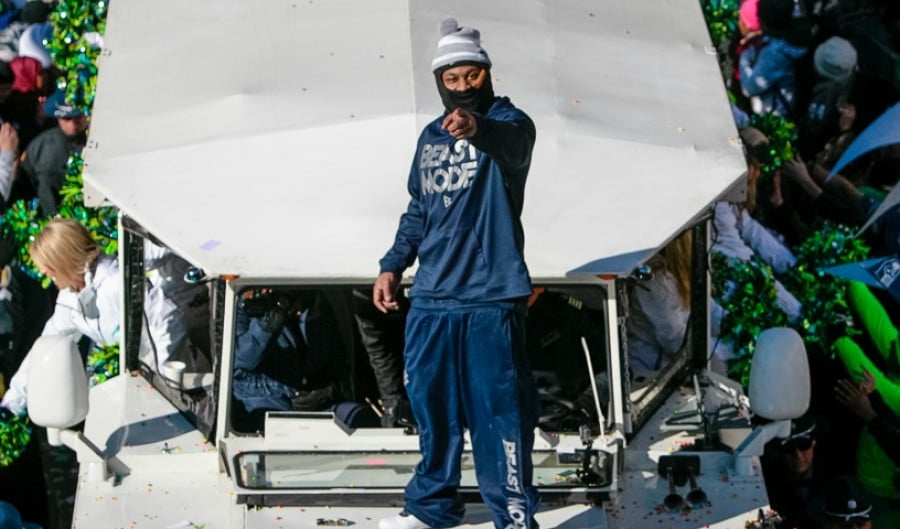Mark my words: protection of athletes’ nicknames & catchphrases in the U.S.

During a pre-Super Bowl interview on January 27, Marshawn Lynch wore a hat featuring his “Beast Mode” logo. By the next day, the hats were completely sold out. In December, Anthony Davis’ trademark application for FEAR THE BROW® was granted registration. Ryan Lochte’s trademark application for JEAH™ has been approved for registration pending proof of use. It seems that nowadays, every JOHNNY FOOTBALL™ or Bill Rafferty runs, jumps, passes and kicks their way to the Trademark Office.
This article explores important considerations for a sports figure’s trademark protection of monikers or catchphrases, including the basics of U.S. registration, related business concerns and two alternative ways that sports figures can protect their names and catchphrases in the U.S., namely right of publicity and false endorsement claims. This article also touches upon international trademark protection. Armed with this information, sports figures can know what URBAN MEYER KNOWS™, get on board the GUS BUS® and monetize their well-known nicknames and catchphrases.
U.S. Trademark Protection
Sports broadcasters are fond of using the word “trademark” to refer to an action associated with a particular athlete – for example, Jimmy Graham celebrating touchdowns with his “trademark” goalpost dunk 1. This description is in the right ballpark, though not the legal definition of a trademark. A trademark is any word, phrase, name, symbol, logo or even sound or scent that is used by an individual or entity to identify its goods or services, and to indicate the source of the goods or services.
In the United States, trademark rights attach when a mark is used in commerce in this manner.2 It is not enough that a sports figure is known by a certain nickname or uses a certain catch phrase. Only when the nickname or phrase is used by the sports figure (or a related entity) in connection with a product or service, can it become a protectable trademark. Note that, while trademark registration confers certain benefits3, a registration is not necessary to establish trademark rights in the U.S., and a third-party cannot usurp a user’s trademark rights by beating the owner to the Trademark Office.
So, what types of goods or services can athletes brand with their trademarks? Essentially, if the product is not illegal, the sky is the limit. Some of the more common products associated with sports figures’ trademarks include clothing and apparel (for example, Darrelle Revis’ registration for REVIS ISLAND), athletic training or instruction (for example, Pete Maravich’s registration for PISTOL PETE) and providing information about sports and sporting events (for example, Bart Scott’s registration for CAN’T WAIT).
Of course, not all sports figures have a product or service to sell the instant that a nickname or catchphrase takes off. In such situations, trademark owners can protect this intellectual property by filing a trademark application based on a bona fide (genuine) intent to use the mark in the future. Once use is proven, the date that the intent-to-use application was filed will be treated as the date of “first use” if a later dispute arises.
Note, however, that mere dreams of a line of sneakers do not constitute a “bona fide” intent to use a mark. Rather, an intent to use a mark is only bona fide if there is objective evidence of that intent at the time that the application is filed (for example, written evidence of a business plan or product design, or proof that one is attempting to secure financing for the product). If the intent is there, sports figures can ensure early protection of their nicknames and catchphrases while they work on bringing their products or services to market.
To continue reading or watching login or register here
Already a member? Sign in
Get access to all of the expert analysis and commentary at LawInSport including articles, webinars, conference videos and podcast transcripts. Find out more here.
- Tags: American Football | Community Trade Mark (CTM) | Europe | Intellectual Property | Merchandising | NCAA Division 1 Manual | NFL | Paris Convention for the Protection of Industrial Property | Super Bowl | Trade Mark | United States of America (USA) | United States Patent and Trademark Office (USPTO) | World Intellectual Property Organization (WIPO)
Related Articles
- Trademarks in sports: an overview - Part 1 of 3
- #OnlinePitfalls – Effective management of sports intellectual property rights on social media platforms - Part 2 of 3
- Brand protection, trademarks, and the event that shall not be named: Event-specific legislation and the Olympic Games - Part 3 of 3
- An overview of ICANN’s gTLD Programme: what do sports brands need to consider to protect their brand?
- Non-traditional trade marks in sports – an EU perspective
- Sponsorship & data trends in sport: legal issues for sponsors & rights holders
- A guide to rights protection at major sporting events: Part 1 - identify rights & managing risk
- A guide to rights protection at major sporting events: Part 2 - educate, monitor & enforce
- A guide to rights protection at major sporting: Part 3- surprises & over enforcement
Written by
Joy J. Wildes
Joy J. Wildes is counsel in the Intellectual Property Practice Group of Davis & Gilbert. She represents advertising agencies, companies and individuals in connection with trademark, advertising, copyright, domain name and corporate intellectual property matters.
Kevin S. Blum
Kevin S. Blum is an associate in the Intellectual Property Practice Group of Davis & Gilbert. Mr. Blum represents companies, advertising agencies and individuals in connection with trademark and other intellectual property matters.





